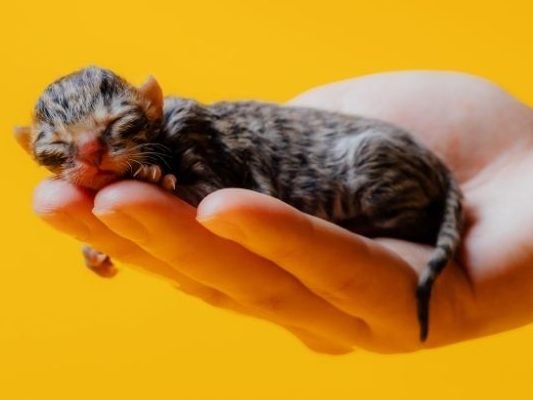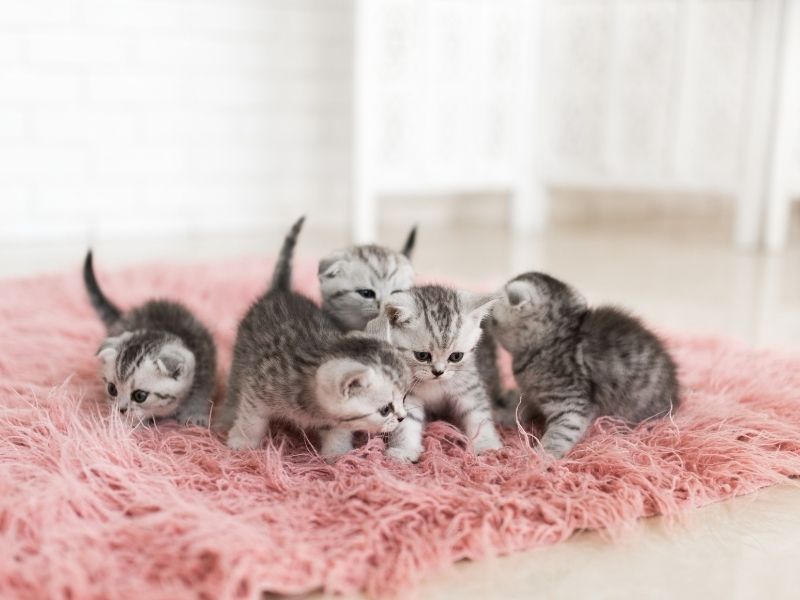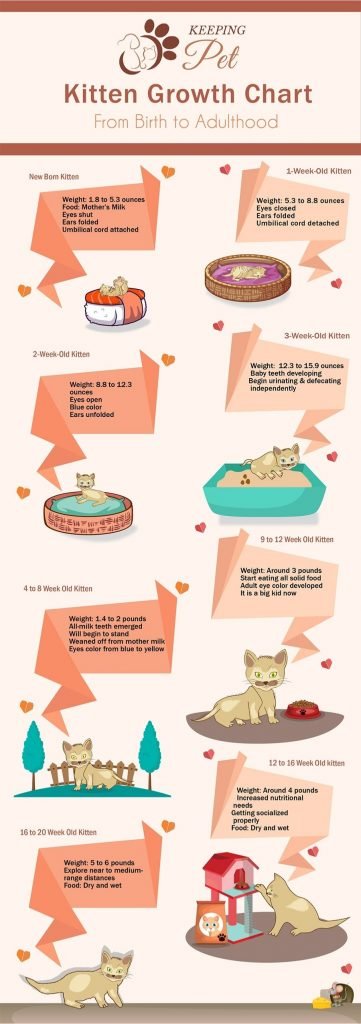The first couple of months of kittens’ lives are a whirlwind of developmental changes. Kittens open their eyes and ear canals, change eye colors, develop teeth, and gradually get weaned off from nursing to eating solid cat food. A lot is happening from kittens’ birth to reaching adulthood, and it is hard for owners, even responsible and caring ones, to keep track of everything.
With developmental changes, the nutritional needs of kittens change every week. Therefore, it is imperative that their owners monitor kittens’ growth timeline with a kitten growth chart and feed them according to a kitten feeding chart.
Kitten Growth Chart
| Age | Weight |
| Newborn Kitten | 1.8 to 5.3 ounces |
| 1-Week-Old Kitten | 5.3 to 8.8 ounces |
| 2-Week-Old Kitten | 8.8 to 12.3 ounces |
| 3-Week-Old Kitten | 12.3 to 15.9 ounces |
| 4 to 8 Week Old Kitten | 1.4 to 2 pounds |
| 9 to 12 Weeks Old Kitten | Around 3 pounds |
| 12 to 16 Weeks old kitten | Around 4 pounds |
| 16 to 20 Weeks Old Kitten | 5 to 6 pounds |
| 6 Months to Adulthood | 6 to 8 pounds |
Newborn Kitten
A newborn kitten will have her eyes shut and ears folded. This helps her eyes to continue developing even after birth. Closed eyes also help them with their hypersensitivity to light. Newborns will also have no teeth or even gums. During this stage, kittens are completely helpless and dependent on their mothers for everything, from feeding to staying warm and mobility. Around an hour or two after their birth, kittens will start nursing. The mama cat will initiate the nursing, helping her kittens to latch on and suckle.
Their umbilical cord will still be attached to their mother and will fall off on its own in 3 to 4 days. Their nose and paws will be pink-colored. If you find them sleeping often, that is okay—newborns sleep for most of the day. The average weight of a newborn kitten ranges from 1.8 ounces to 5.3 ounces.
Premature Kitten
Many times, kittens come to this world at a premature stage. They are very weak and lower in weight than the average newborn kitten. With lower weight, premature kittens also have very small body sizes, and often, there is little to no fur on most of their body. These fragile kittens do not even have the energy to crawl to their mothers or even hold their heads up. Like a premature kitten, a runt kitten of the litter would also require some extra care. They will also need their pet owners to guide them to their mother’s nipples. You will have to maintain a runt kitten growth chart to monitor their weight gain closely.

1-Week-Old Kitten
One-week-old kittens will no longer be directly attached to their mothers with the umbilical cord, but their eyes will still be shut. Their ears will start unfolding around the 7th day of birth, and their eyes will slowly begin opening between 8 to 12 days. One eye might open more quickly than the other. But you should not intervene to help them open their eyes. It is best that kittens open their eyes themselves. During this stage, your kitten will have blue eyes but don’t get attached to the eye color of your kitten, as with age, it will transition into an adult eye color.
The one-week-old kitten must have doubled their birth weight. On average, one-week-old kittens should weigh between 5.3 and 8.8 ounces.
And since one-week-old kittens cannot urinate or defecate independently, they will need stimulation from their mothers. Anogenital grooming done by mother cats through licking stimulates the bowel movements of baby kittens, helping them eliminate with ease. The mother cat then consumes whatever her baby kittens eliminate. This may sound weird, but it is crucial for the kitten’s health and cleanliness.
2-Week-Old Kitten
At this stage, your kitten will have its eyes opened and ears unfolded. While most kittens open their eyes by the 10th day, some may take even a bit longer. If they are not by the age of two weeks, you should consult your veterinarian. However, the kitten would still not have any teeth, and its claws would still be non-retraceable. Two-week-old kitten size should range between 8.8 to 12.3 ounces. Their eyes would still be blue, and their ears small and round.
With their eyes fully opened, baby kittens could also locate their mother’s nipples easily and initiate nursing. But still, they will need the mother cat to cooperate and lie on her side. However, two-week-old kittens will still not be able to urinate and defecate on their own. You will still find mama cats licking their kittens, stimulating the process of elimination, and later cleaning them up.
If you have rescued or adopted an orphaned or abandoned kitten, you will have to play the role of the mama cat. You will have to feed her a Kitten Milk Replacer (KMR) with a kitten feeder. You will also have to stimulate them to urinate and defecate and will also have to nurse them and clean them up. To stimulate the baby kitten to urinate, you should use a soft disposable cloth or tissue and rub it around its genitals until they are done urinating. Similarly, if you think the kitten needs to defecate, you should stimulate her bottoms until she has finished her business.
Kittens have very sensitive skin and are at a greater risk of developing urine and fecal scald if not cleaned properly. Therefore, it is advised that you clean the kitten well with a soft wet cloth or a pet wipe specially designed for cats. Never use baby wipes on kittens or even adult cats. You should also take the newly adopted or rescued kitten to the vet as soon as possible to get an idea about her overall health and get her vaccinated for deadly feline diseases.
3-Week-Old Kitten
At this age, kittens will still have blue eyes, but their round ears will begin to point upward. Your kittens will start to develop their sense of hearing at this stage. If you open your kitten’s mouth, you might find tiny teeth growing at the front of the mouth. By now, kittens might start urinating and defecating on their own, but mother cats will still be responsible for cleaning up their waste. On average, the size of a 3-week-old kitten should vary between 12.3 to 15.9 ounces.
The tiny paws of a three-week-old kitten would become retraceable. If your baby kittens are healthy, they may start purring and exploring the nearby spaces. They will also start recognizing and playing with their littermates.
4 to 8 Weeks Old Kitten
Your cat would start developing canines during week 4 and premolars during week 5. By week 6, your kitten’s teeth will be nearing the final stage of early development. If you want her to develop healthy chewing, you might consider Petstages Dental Kitty Chew Wheel Catnip Cat Toy, which encourages healthy chewing. You should also develop a habit of brushing your cat’s teeth regularly.
At this stage, the kitten would have fully developed its vision. Cats are not colorblind. So, with a fully developed vision, your cat will be able to see blue and gray and a wee bit of yellow and green.
However, its eyes would still be blue. A 5-week-old kitten would initiate all the nursing herself but would require cooperation from her mother. By now, baby kittens will be urinating and defecating on their own in nearby places without any prior stimulation from their mothers. So it would be best if you start potty-training your kitten. You should try different types of cat litter until you find the one that your kittens seem to like.
At this stage, baby kittens would also start grooming themselves, but the mama cat would still provide some grooming.

With eyesight and hearing senses fully developed, a 6-week-old kitten would start playing with its littermates and interacting with her mother. She will also start exploring short distances independently, without her mother’s support. On average, a 6-week-old kitten’s size should be 1.4 to 1.7 pounds. The kitten weaning process will start during the sixth week; by then, mother cats would have to bring some fresh solid food for their kittens. A 7-week-old kitten will be fully weaned off and consuming more solid food. If your kitten is not from one of the cat breeds with blue eyes, her eye color will start transitioning from blue to yellow.
By the age of 2 months, your kitten should be weighing around 2 pounds. At this age, you will notice the testicles of your male kitten descending into the scrotum, according to VCA Hospital.
9 to 12 Weeks Old Kitten
For a kitten growth chart, the rule of thumb is that a kitten will grow around 1 pound per month on average during the first six months. Therefore, a 3-month-old kitten’s size should be around 3 pounds. At this stage, kittens would start eating all solid food. It would also start bonding with its caregivers. At the age of 3 months, your kitten will have developed all of its baby teeth, which will soon start falling out. Kittens would also have developed their adult eye color.
12 to 16 Weeks Old Kitten
This is an intense growth period for your kitten. You will need to provide for their increased nutritional needs. Their appetite will increase—you will notice that your kitten will always be hungry. A four-month-old kitten’s size should be around 4 pounds. If you cannot feel any testicles in your male kitten’s scrotum at this stage, you can assume that your kitten has a condition named cryptorchidism, in which male kittens fail to develop one or both testicles.
16 to 20 Weeks Old Kitten
During this stage, your kitten will start behaving like an adult cat. They will start growing independent from their mother, exploring near to medium-range distances and playing with her other feline fellas. A 5-month-old kitten should weigh between 5 to 6 pounds. It is time to bring her some cat toys and trees and set up cat window perches around.
6 Months to Adulthood
By 6 months, your kitten will look like a little adult, trying to emulate her mother and other adult cats around her. Your cat might seem to be gaining weight disproportionately, but you do not need to fret about that. With time, your cat will start growing its long thin legs. On average, a 6-month-old kitten should be around 6 to 8 pounds.
If the testicles of your male kitten are nowhere to be seen in his scrotum, even at the age of six months, it means that your kitten has cryptorchidism. The testicles are retained in his abdomen or inguinal canal. There is a huge risk that retained testicles become cancerous. Therefore, cat owners are strongly advised to consult a vet and neuter their male kittens with cryptorchidism, provided that the vet suggests the same.
Your kitten will sexually mature between 4 to 9 months of age and will stop growing by 12 months. While most cats reach adulthood by the age of 12 months, others might need a little more time—14 months or even two years.
It is advised that if you are not planning on breeding your male and female kittens, you should get them spayed before they reach puberty. Female kittens experience their first heat cycle at around the age of 6 months. So, if not fixed, male litter may end up impregnating female kittens in the litter. Because of such unplanned pregnancies, cat owners often have to consider spaying pregnant cats.
If kittens are intact and have reached puberty, you should familiarize yourself with the signs of cat pregnancy so that you can identify if any of the kittens are pregnant. You may also want to take a quick look at the cat pregnancy timeline and pregnant cat care tips to provide the best possible care to your pregnant cat.
Different breeds of cats reach puberty at different ages; therefore, it is advised that you talk to your vet and decide what the optimal age to fix your cat is. Fixing improves the lifespan of your kitten by reducing the risk of developing many serious diseases.

Use the above kitten growth chart to judge if your kitten is growing properly. Keep in mind that the above-discussed weights are average, and your kitten might be smaller or larger than average, depending on its breed. But if your kitten appears to have a weight too low or higher than the average weight, you need to immediately consult your vet to check if there is something wrong with your kitten.
